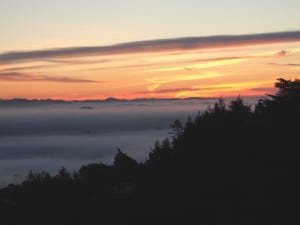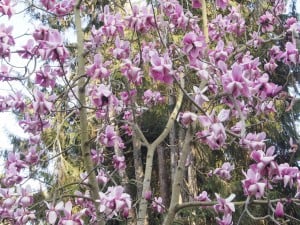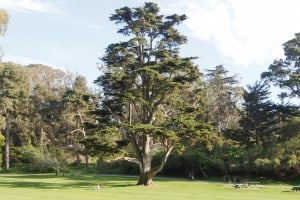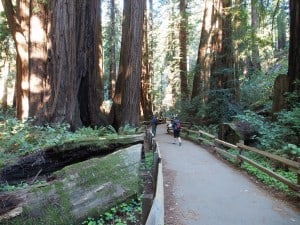Seeing exciting new plants and animals often requires effort – maybe rising at dawn and setting off on a long hike or driving for hours to some far-flung destination. Getting easy, close-up looks at iconic species right in the heart of a metropolis is therefore quite a treat. Such was our experience in a two-week trip to the San Francisco and Monterey areas. It was heartening to see how well species ranging from sea otters and elephant seals to monarch butterflies and spotted owls are doing in such a populated area of California.
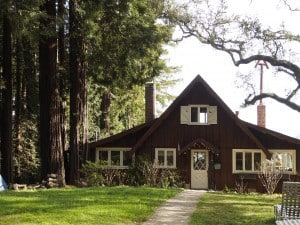
We rented the ground floor of this beautiful old Mill Valley home on the side of Mt. Tamalpais (Photo: Drew Monkman)
This was our first visit to the Golden State. My wife, daughter and I took advantage of a family wedding to make an extended stay and explore some of California’s fascinating nature, culture and history. For the first five days, our home base was Mill Valley, a lovely town located just north of the Golden Gate Bridge and set in picturesque wooded canyons. From the house we rented high on Mount Tamalpais, we awoke each morning to beautiful sunrises over the fog-covered valley and San Francisco Bay. Ravens and red-tailed hawks soared constantly overhead, their calls an unbroken presence. Anna’s hummingbirds darted among the blossoms in the garden, stopping from time to time to perch on an orange tree, while white-crowned and golden-crowned sparrows foraged on the ground. A dense forest of coastal redwoods bordered the property, providing both privacy and a sense of connection with an older, wilder California. The air was replete with the smell of the white jasmine vines that adorned the deck. The roadside down to Mill Valley was bordered by yellow-flowered acacia trees, interspersed among lofty, fragrant eucalyptus.
Nearby Sausalito, famous for its houseboats and upscale hillside homes, was also a delight. Harbour seals and sea lions hunted just offshore, attracting hoards of western and California gulls each time they surfaced with food. Brown pelicans glided low above the water while loons, grebes and cormorants dove for food further out in the bay. Alcatraz Island and the imposing skyline of downtown San Francisco loomed in the distance.
San Francisco
Following a great four-hour guided tour of San Francisco to get our bearings, we returned to the City by the Bay to wander its charming neighbourhoods like Pacific Heights and Russian Hill. Everywhere we walked – often huffing and puffing on the ridiculously steep hills – the streets were bordered by beautiful, pastel-coloured houses, many of Victorian style but none exactly alike. Bushtits, white-crowned sparrows and Oregon dark-eyed juncos flitted among the shrubs and trees of house-front gardens where red-flowered camellias, magnolias, candelabra aloes, and plums were in full bloom. The parade of different scents, too, was intoxicating. San Francisco is pursuing an ambitious urban forest plan, which was evident by the huge number and variety of new trees planted along the sidewalks. Many of them had watering bags zipped around the support posts.
At Telegraph Hill, a famous San Francisco landmark and site of the Coit Tower, California towhees fed on the ground, while Wilson’s warblers and western scrub jays called from the iconic Monterey cypress trees. At one point, a flock of red-masked parakeets (also known as cherry-headed conure) passed noisily overhead, making me wonder if I wasn’t somewhere in South America. Native to Ecuador, these birds were released in San Francisco decades ago – probably by frustrated pet owners – and are now reproducing on their own.
On Pier 39, at busy Fisherman’s Wharf, we got close-up looks at a colony of California sea lions, a fixture here since 1989. The Marine Mammal Store and Interpretive Center monitor the sea lion population each day, and educational information is provided to tourists. Sea lions can be distinguished from seals by the presence of external ear flaps and their ability to walk on land. Seals only have ear holes and move on land by flopping on their bellies.
Golden Gate Park
The crown jewel for exploring nature in San Francisco is Golden Gate Park. At five kilometres long and a kilometer wide , it is 20 percent larger than Central Park in New York. We spent an afternoon touring the park by bicycle. In addition to native trees like coast redwoods, Douglas fir and Monterey cypress, numerous non-natives like eucalyptus border the streets, pathways and meadows. It was hard to bike very far without stopping to take a picture or to grab our binoculars. The park contains a chain of lakes where we spotted a variety of waterfowl, including ruddy duck, American wigeon and bufflehead. Wading birds like green herons and both snowy and great egrets were common, too. Along the trails, black phoebes, Brewer’s blackbirds, chestnut-backed chickadees and the ubiquitous white-crowned and golden-crowned sparrows popped up continuously.
A must-see for anyone visiting the park is the 55-acre San Francisco Botanical Gardens. We spent most of our time exploring the California Natives and rhododendron sections, where dazzling pink and white magnolias were in blossom. The California section provides a great overview of the state’s flora and was our introduction to species such as manzanitas, madrone, live oaks, Ceanothus, California buckeye, and California bay laurel. We also enjoyed an interpretive trail that takes you through the story of plant evolution, from the spore-bearing plants of the Devonian period to the flowering plants of the Eocene.
At the end of the trip, I also spent several hours at the California Academy of Sciences. It is one of the largest museums of natural history in the world, housing over 26 million specimens. Completely rebuilt in 2008, the museum is at the forefront of environmentally friendly design. Most impressive is the two and a half acre green roof, which is planted with over a million California native species. A huge glass dome encloses a living rainforest, and the aquarium section includes a living coral reef, tide pool and the underwater ecosystems of the California coast. The Africa Hall has a fascinating exhibit on human evolution, while the earthquake section explains how seismic activity and plate tectonics has shaped both California and the world. There is also a superb exhibit on the role colour plays in nature, a naturalist centre, and docents to answer questions and provide hands-on experiences with many species. Along with the botanical park, the museum serves as a great introduction to the natural history of the state.
Muir Woods
Before we left Mill Valley, we paid a much-anticipated visit to nearby Muir Woods National Monument. The park protects 554 acres of old-growth coastal redwood forest. The trees are often shrouded in fog, which provides up to half of their water needs. Related to the giant sequoia of the Sierra Nevada, many of the trees are over 200 feet tall and between 500 and 800 years old. Other common trees include California bay laurel, bigleaf maple and tan oak. The forest is also home to northern spotted owls, which appear to be thriving.
By arriving early on a weekday, we had the trails mostly to ourselves and could enjoy the calls of Steller’s jays and the remarkably long, tinkling trills of the Pacific wren. The forest floor was carpeted with horsetails, ferns and blooming redwood sorrel, interspersed here and there by Western trilliums, fetid adder’s tongue and vermillion cap mushrooms. We were also fascinated by the eight-inch banana slugs that glided across the forest floor.
The park is named after naturalist John Muir who once wrote, “This is the best tree-lover’s monument that could possibly be found in all the forests of the world.” His efforts to preserve the natural landscape of America earned him the title “Father of the National Park System.”
Later the same day, we made a short but beautiful drive to Stinson Beach on the Pacific coast. In addition to spectacular scenery, the beach is home to overwintering shorebirds like marbled godwits and willets. As we walked along the sand, we also got great views of Heermann’s gulls, resplendent in their dark grey breeding plumage. This area is also an overwintering site for monarch butterflies. With temperatures of over 20 C, the butterflies had already begun to disperse. We watched as dozens flew about in pairs, some stopping to mate on the grass. Instead of going to Mexico, the monarch population west of the Continental Divide fly to the coast of California to spend the winter. They cluster together by the hundreds or even thousands on the branches of pines, cypress and eucalyptus trees.
The San Francisco area was just a foretaste of the natural wonders we were to experience in California. The second week took us south to the Monterey-Big Sur area and then north again to Point Reyes National Seashore. More about these next week.
